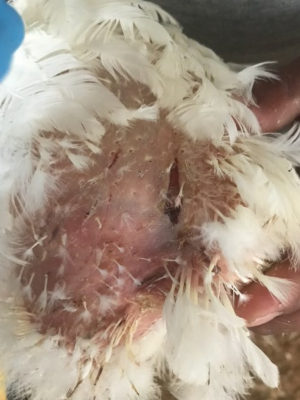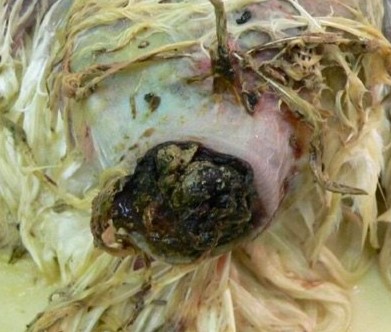By Gino Lorenzoni
Definition
Interruption of the skin continuity in areas with or without feathers.
Etiology
Wounds are caused by fights among pen mates, predatory behavior of pets, wildlife attempting to prey on poultry, sharp materials near the coop or nests.
Occurrence
Wounds are a fairly common finding in poultry and can certainly occur in most production systems. There are several factors associated with the generation of wounds. Cages, perches, and other equipment with sharp edges or exposed nails or wire ends. Wounds tend to be more common in cage-free operations where birds are exposed to predatory animals like birds of prey, foxes, raccoons, or even domestic animals with predatory instincts like cats and dogs. Confined animals are also susceptible: birds fighting for territory, pecking during oviposition, and cannibalistic behavior are the most common causes of wounds in confined poultry.
Clinical manifestations
Damaged skin, open skin (figure 1), blood on skin or feathers, inflamed skin, hematomas, pale combs, and wattles after extreme bleeding (anemia).

Figure 1

Figure 2
Necropsy findings
Superficial wounds (Figure 1) can also lead to infections of the skin and death. In this case, the skin will look wet and there is often severe inflammation of subcutaneous tissue including congestion, caseous exudate, and sometimes crepitation of the tissue (when there is contamination with gas-producing bacteria). Perforating wounds such as cloacal pecking (Figure 2) can lead to peritonitis and death. The necropsy will reveal abdominal infection in the form of exudate (serous or caseous) and intensive congestion in the blood vessels irrigating the intestine, air sacs, and fat pads.
Prevention
Prevention will depend on the root cause of the wounds.
- Fights with pen mates for dominance is common on mature male chickens. A solution for this can be to separate the males; reduce the number of males to one in very small flocks; increase the number of hens per male and increase the size of the pen so each male can focus on his own territory. As a rule of thumb, 10-12 female chickens need to be allocated per each male. This can vary depending on the species.
- Consumption of an unbalanced diet may lead to cannibalistic behavior. Feeding the birds, a commercial balanced diet may solve the issue. Supplementing the diet with some hay may also work. Fiber will serve as a substrate for millions of bacteria in the ceca which could bring a nutritional benefit. Certainly, hay keeps the birds busy for some and can serve as a distraction which could sometimes help to keep the birds from fighting.
- In free-range situations, birds can be more susceptible to becoming prey. Birds of prey are notorious for attacking free-range poultry. Avoid putting your birds close to tall trees where birds of prey can perch. Avoid putting birds close to shrubs and tall vegetation which can serve for foxes, coyotes, and raccoons to hide.
- Pens and nests should not have exposed nails or sharp edges. Check your premises for sharp edges and take corrective actions.
- Supply enough feeder and waterer space to avoid having birds climbing on each other’s backs which generate scratches that can get contaminated.
Treatment
Always clean the affected area. Sometimes, blood sticking on the surface of the feathers make the wound look much worse than what it really is. Lukewarm water can help to remove dirt and blood from the affected region. For proper cleaning and inspection, it may be necessary to remove some feathers. Body feathers can be safely trimmed with a pair of scissors. Note that the primary and secondary feathers from the wing (big feathers of the wing) have a blood vessel near its base. Cutting the shaft of these feathers can lead to continuous bleeding due to a capillary suction effect on the severed shaft. If a primary or secondary wing feather must be removed, because it is broken or to clean an affected area, the feather must be plucked out of the follicle. This will lead to some bleeding that will subside after applying gentle pressure in the area. After the area is free of blood and feathers it should be washed with water containing a weak solution of disinfectant (for example Chlorohexidine 2%). Stitches may be needed to bring the borders of the skin together in large wounds. Apply some unguent containing topic antibiotic.
Ideally, the bird with a wound should be separated from the flock. Otherwise pen mates may try to peck on the wound making it worse (and eventually killing the wounded bird). If the bird must be placed back in its original pen (in case of minor wounds only) disguise all the blood from the wound zone with a dark antiseptic spray and observe how the pen mates react before leaving the coop. If other birds show any interest in the wounded area, remove the animal immediately. In addition to killing the wounded bird, some of the pen mates may develop a vicious cannibalistic behavior that will be very difficult to eradicate leading to more wounded and dead animals.
Source : psu.edu